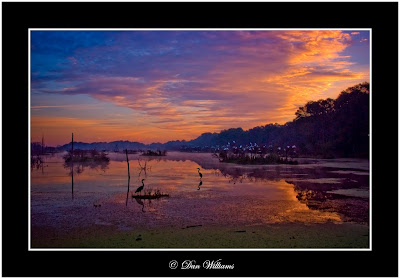
For many years, I carried my camera around looking for great shots. Then one day I discovered that I had a new skill .........I could design a shot........I could anticipate a shot.........I could wait for a shot..........I could allow my vision to be realized on film, and that was the day that I became a photographer. After years of hoping for the shot, I discovered that I could scout a location and make plans for a shot that was pre-visualized in my mind. From that point on my images took on a new sense of passion, and the excitement for me as a photographer grew immensely.
This shot of Harris Neck Wildlife Refuge was taken at dawn, after making several previous trips
to the refuge without any meaningful images. The location drew me over and over again, but my timing was never right. It seems like something always managed to prevent me from getting the shot I wanted. Then, one evening while sitting in my hotel, I saw an image in my mind of what I wanted from this location. I asked myself, "What would you do if you were painting this scene?" Instantly, I began composing an image in my mind of what my painting would look like and asking myself how I could get it in the camera. I knew the light was the key, and that sunrise was going to be my best chance of capturing the birds in the rookery. That meant getting on location early and using a small portable blind. While still dark, I hiked into the marsh, set up my blind and waited. As daybreak came, so did my shot. Perhaps not exactly as I had pictured it in my mind, but very close.......and maybe even better.
My images today are not usually "by chance." Rather, most of them are well thought-out and planned. In doing so, I make myself aware of light and of composition. I place myself in a ready position that is going to give me the scene I want, and I wait for the light. Sometimes I get to click the shutter, but so many times I simply enjoy the morning without getting the shot. Not every outing has to produce a winner. Sometimes it's enough to just enjoy what's in front of you.


































